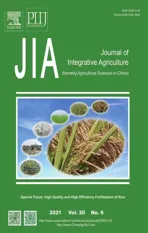ldentification of eight Berberis species from the Yunnan-Guizhou plateau as aecial hosts for Puccinia striiformis f.sp.tritici,the wheat stripe rust pathogen
2021-05-23LlSinanCHENWenMAXinyaoTlANXiaxiaLlUYaoHUANGLiliKANGZhenshengZHAOJie
Ll Si-nan,CHEN Wen ,MA Xin-yaoTlAN Xia-xiaLlU YaoHUANG Li-liKANG Zhen-shengZHAO Jie
1 State Key Laboratory of Crop Stress Biology for Arid Areas and College of Plant Protection,Northwest A&F University,Yangling 712100,P.R.China
2 Guizhou Institute of Plant Protection,Guizhou Academy of Agricultural Sciences,Guiyang 550006,P.R.China
Abstract Puccinia striiformis Westend.f.sp.tritici Erikss.(Pst) infects wheat and causes stripe rust. The rust is heteroecious with wheat as the primary uredinial and telial host and barberry (Berberis spp.) as the alternate pycnial and aecial host. More than 40 Berberis species have been identified as alternate hosts for Pst,and most of these are Chinese Berberis species. However,little is known about Berberis species or their geographic distributions in the Yunnan-Guizhou plateau in southwestern China.The Yunnan-Guizhou plateau is considered to be an important and relatively independent region for the evolution of the wheat stripe rust pathogen in China because the entire disease cycle can be completed within the region. In this study,we conducted a survey of barberry plants in the Yunnan-Guizhou plateau and identified the eight Pst-susceptible Berberis species under controlled conditions,including B.julianae,B.tsienii,B.veitchii,B.wilsonae,B.wilsonae var.guhtzunica,B.franchetiana,B.lepidifolia and B.pruinosa. These species are reported here for the first time to serve as alternate hosts for the wheat stripe rust pathogen under controlled conditions.
Keywords: Berberis spp.,alternate host,Puccinia striiformis f.sp.tritici,sexual reproduction,stripe rust,wheat,yellow rust
1.lntroduction
Puccinia striiformisWestend.f.sp.triticiErikss.(Pst) causes stripe rust (yellow rust) of wheat.Pstis a heteroecious rust fungus that infects wheat (Triticumspp.) as a primary host and barberry (Berberisspp.) andMahoniaas alternate hosts to complete the macrocyclic life cycle (Jinet al.2010;Wang and Chen 2013;Zhaoet al.2013). Wheat stripe rust is a destructive disease which threatens wheat production in the wheat-growing regions throughout the world (Chen 2005;Wanet al.2007;Aliet al.2009;Hovmølleret al.2010;Wellings 2011).
China is the largest epidemic region of wheat stripe rust in the world. The Chinese epidemic region of the disease is subdivided into three zones consisting of the North-Northwest epidemic zone,Xinjiang epidemic zone and Southwest epidemic zone (Li and Zeng 2002). As an important region of the Southwest epidemic zone,the Yunnan-Guizhou plateau is a low-latitude highland located in the Southwest of China,where wheat is grown in multiple seasons and wheat growth stages are overlapping in seasons around the year due to the mild local weather conditions. In this region,wheat stripe rust is an important factor affecting local wheat production and has caused massive yield losses in the past decades. Urediniospores produced in this region also contribute to stripe rust epidemics in other regions (Li and Zeng 2002;Zuoet al.2009). The annual average area of infected wheat in Yunnan Province reached 200 000 hectares from 1979–2003 (Lüet al.2004;Li 2013),accounting for one third of the wheat growing area. In this region,Pstcaused five large-scale epidemics from the 1960s to the 1980s,and the frequency of epidemics has increased since the late 1990s (Li 2004).Nine epidemics have been reported from 2001 to 2009 in this region,and in 2002,up to 50% of the planted wheat area was seriously infected (Li 2013). Similarly,Guizhou Province is also an important region with frequent wheat stripe rust occurrence. In 2017,wheat stripe rust affected 64 300 hectares,accounting for approximately 14% of the annual area of growing wheat (Huanget al.2018).
China has more than 250Berberisspecies,accounting for more than half of the number of species reported in the world (http://foc.iplant.cn/content.aspx?TaxonID=103816).The Yunnan-Guizhou plateau has nearly one hundredBerberisspecies. To date,the geographic distribution of theBerberisspecies that can be alternate hosts forPstin this region is largely unknown. Only tenBerberisspecies,includingB.ferdinandi-coburgii,B.phanera,B.aggregatavar.integrifolia,B.davidii,B.wangii,B.platyphylla,B.jamesiana,B.vernalis,B.coryi,andB.guizhouensis,have been surveyed at four investigated sites in Yunnan and Guizhou provinces. Nine of which,the first nineBerberisspecies listed,were collected from three investigated sites in Yunnan,whileB.guizhouensiswas reported from merely one investigated site in Guizhou. Eight of thoseBerberisspecies have been identified as alternate hosts forPst. TwoBerberisspecies native to Yunnan,B.vernalisandB.coryi,showed high resistance toPstbased on observations of no signs of infection after triple inoculation tests usingPstbasidiospores (Zhaoet al.2013). However,the lack of knowledge concerning the otherBerberisspecies in major wheat production regions of the Yunnan-Guizhou plateau limits the understanding of potential roles ofBerberisspecies as alternate hosts forPstand their geographic distributions in this region. Therefore,the objective of this study was to determine the geographic distributions of the variousBerberisspp.in the region and their susceptibility toPst.
2.Materials and methods
2.1.Field surveys and collection of Berberis species
Field surveys ofBerberisspecies were conducted in the flowering period (April–June) and the berry period(August–October) in Yunnan and Guizhou provinces in 2016 and 2018. During the surveys,information on latitude,longitude and elevation were recorded using GPSmap(60CSx,Garmin,USA). Leaves,flowers and berries or young plants of eachBerberissample were photographed and collected for identification to species. The number of bushes for eachBerberisspecies in an area of 0.5 km radius was visually estimated.Berberisspecies collected from the Yunnan-Guizhou region were identified by comparisons with recorded species in genusBerberisusing the Chinese botanical monographFlora of China(e-version website:http://foc.iplant.cn/) based on the morphological characteristics of the leaves,flowers,and fruits.
2.2.Cultivation of barberry plants
Young plants ofBerberisspecies without observed berries during the field surveys were transplanted in pots filled with potting mix (Inner Mongolia Mengfei Biotech Co.,Ltd.,Huhhot,Inner Mongolia,China). All plants were grown in a greenhouse at 20 to 25°C with a routine 16-h light/8-h dark diurnal cycle. The light intensity was supplemented to 8 000 to 10 000 lux with high-voltage sodium lamps. After emergence of 2–3 new leaves,the barberry plants were inoculated withPstbasidiospores produced from germinated teliospores to test for susceptibility as described below.
For theBerberisspecies plants with berries collected during the surveys,the berries were peeled off to obtain seeds. The seeds were cleaned using tap water,placed on three layers of filter paper in a Petri dish,covered with a filter paper to prevent the seeds from floating on the surface of the water and soaked overnight in de-ionized water. After seeds fully absorbed water,the water was discarded,and the Petri dish was moved to a growth chamber at 16°C to 20°C with a photoperiod of 16 h light/8 h dark until the seeds germinated. When the first true leaves appeared,the barberry seedlings were transplanted into pots filled with potting mix and moved into the greenhouse with the same conditions as mentioned above. Four-to six-leaf barberry seedlings were used for inoculation.
2.3.Collection of wheat tissues bearing teliospores and growing wheat plants
Green wheat leaves containingPsttelia were collected from Yunnan Province and dried at room temperature for 2–3 days. The leaf tissues were placed inside a plastic zip bag with blue silica gel (HG/t2765.4-2005,Qingdao Haiyang Chemical Co.,Ltd.,China) before sealing. The bag was placed in a desiccator and stored at 4°C for later use. About 10 seeds of wheat cultivar Mingxian 169,which is highly susceptible to known ChinesePstraces,were planted in a small plastic pot (7 cm×7 cm×8 cm) filled with potting mix. Pots were placed in a plastic tray filled with water for subirrigation and kept in a rust-free growth chamber under the same conditions mentioned above for growing barberry plants.
2.4.Tests of Berberis spp.for Pst susceptibility
Teliospore germination and barberry plant inoculations were carried out according to the method described by Zhaoet al.(2013). The barberry plants were inoculated using basidiospores developed from germinated teliospores,incubated in a dew chamber (I-36DL,Percival,USA) at 100% relative humidity (RH) for 3-4 days at 16°C in an alternative condition of 16 h light/8 h dark prior to being moved to a growth chamber. The inoculated plants were transferred to a growth chamber with a photoperiod of 16 h light/8 h dark at (13±3)°C. When pycnia at infected sites oozed visible liquid nectar (containing pycniospores) from ostioles (pycnial openings),fertilization was conducted by transferring nectar of one pycnium to another using a clean detached segment of wheat leaf. After the nectar transfers,the barberry plants were covered for 2 days with a transparent plastic cylinder made by rolling an A4-sized plastic film (0.2 mm thick,Deli Group Co.,Ltd.,Zhejiang,China) for continuous production of the nectar to ensure completion of fertilization,and then the plastic cover was removed from the barberry plants. The plants were observed for aecial formation on the abaxial surface of the inoculated barberry leaves.
2.5.lnoculation of wheat plants with aeciospores
Aecial cups containing aeciospores were excised from inoculated leaves ofBerberisplants using a scalpel,placed onto a clean glass slide,and crushed gently with the scalpel to release aeciospores. Aeciospore suspensions were made by mixing with one or two drops of deionized water(approx.50–100 μL). Each suspension was transferred onto wheat leaves (cv.Mingxian 169) using a hand-made metal inoculation tool with a flat end. The inoculated plants were moved into a dew chamber with 100% RH at 10°C in the dark for 24 to 36 h. After incubation,the plants were transferred to a growth chamber under the same conditions as mentioned above for the growth of barberry plants. At 18 to 20 days post inoculation,uredinial sporulation on the inoculated wheat leaves was observed and recorded.
3.Results
3.1.Distribution and species of Berberis in the Yunnan-Guizhou plateau
A total of 49 sites in the Yunnan and Guizhou provinces were investigated for the species and distribution of barberry plants (Appendix A). Barberry plants were found at 43 sites and commonly grew on hillsides adjacent to crop fields including wheat fields. Of 14 sites investigated in Guizhou,13 (93%) had barberry bushes. In Yunnan,30 of 35 investigated sites (86%) had barberry plants. EightBerberisspecies were identified and collected in both provinces(Table 1). In Guizhou,five of theseBerberisspecies,B.julianae,B.tsienii,B.veitchii,B.wilsonaeandB.wilsonaevar.guhtzunica,were found (Fig.1),andB.wilsonaevar.guhtzunicawas the most widespread in this region (Fig.2;Appendix A). In Yunnan,fiveBerberisspecies,B.julianae,B.wilsonae,B.franchetiana,B.lepidifoliaandB.pruinosa,were identified (Fig.1),andB.pruinosawas the most widely distributed species (Fig.3;Appendix A). Two species,B.wilsonaeandB.julianae,were observed in both provinces(Table 1).
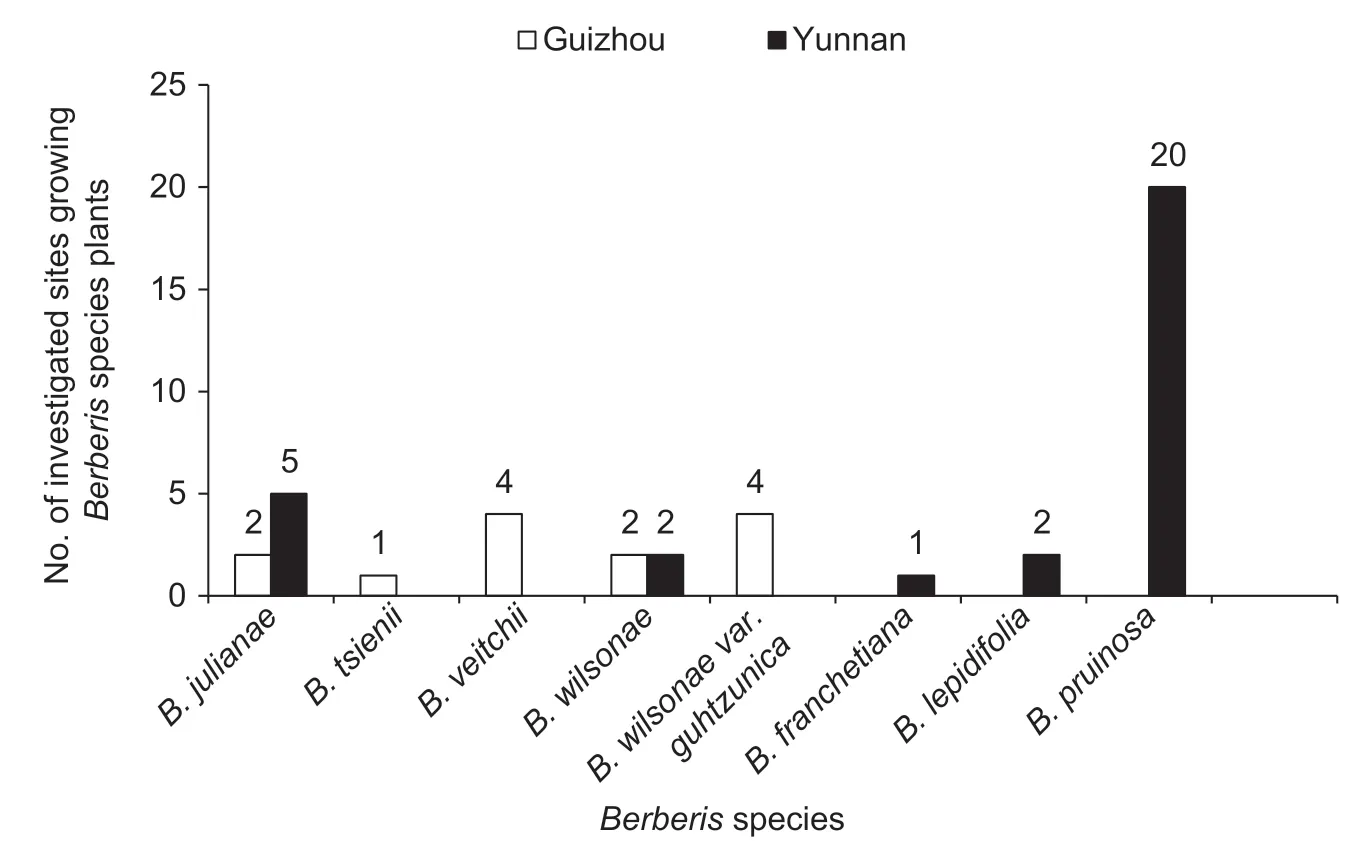
Fig.1 The number of investigated sites with bushes growing for each Berberis species in the Yunnan-Guizhou plateau,China.
3.2.Susceptibility of Berberis species to Pst
After inoculation withPstbasidiospores developed from teliospores collected from wheat,all eightBerberisspecies collected from Yunnan and Guizhou were susceptible toPst. The inoculated barberry plants produced obvious pycnia on the adaxial surface of their leaves 9 to 11 days after inoculation (Fig.4-A1–H1). Aecia (aecial cups)were observed on the adaxial surface of leaves 16 to 20 days post inoculation (Fig.4-A2–H2). Various lengths and numbers of aecial cups were observed on the testedBerberisspecies (Fig.4-A3–H3). After inoculation with aeciospores collected from plants of each of the eightBerberisspecies,uredinia were produced on the surface of leaves of Mingxian 169 wheat seedlings (Fig.4-A4–H4).The results indicated that each of the eight testedBerberisspecies,B.julianae,B.tsienii,B.veitchii,B.wilsonae,B.wilsonaevar.guhtzunica,B.franchetiana,B.lepidifolia,andB.pruinosa(Table 1),were susceptible toPstand could serve as alternate hosts forPstunder controlled conditions.
4.Discussion
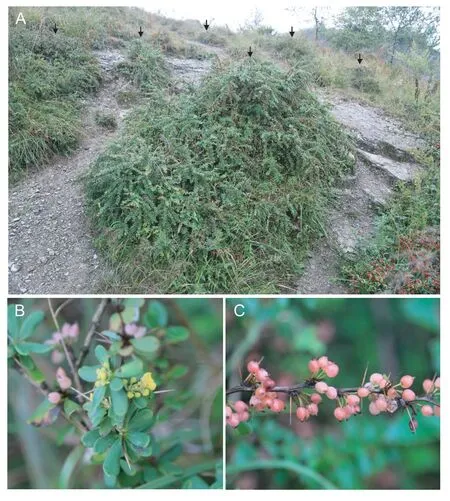
Fig.2 Bushes of Berberis wilsonae var.guhtzunica growing near Shabao Town,Nayong County,Guizhou Province,China observed in October,2018. A,bushes (indicated by black solid arrows). B,shoots with flowers. C,berries.
Identification ofBerberisspecies for susceptibility toPstis the first step in determining whether these alternate hosts play any role in the pathogen variation and contributing to stripe rust epidemics in the wheat crop. Since the discovery that barberry species can serve as alternate hosts forPst(Jinet al.2010),45Berberisspecies collected from different countries,including the U.S.(Jinet al.2010),China (Zhaoet al.2013,2016;Duet al.2019;Zhuanget al.2019),and Pakistan (Mehmoodet al.2019),have been reported to be susceptible toPst. In the present study,the eightBerberisspecies collected from the Yunnan-Guizhou plateau,B.julianae,B.tsienii,B.veitchii,B.wilsonae,B.wilsonaevar.guhtzunica,B.franchetiana,B.lepidifoliaandB.pruinosa,were reported here for the first time and added to the list of susceptibleBerberisspecies that have been reported previously.
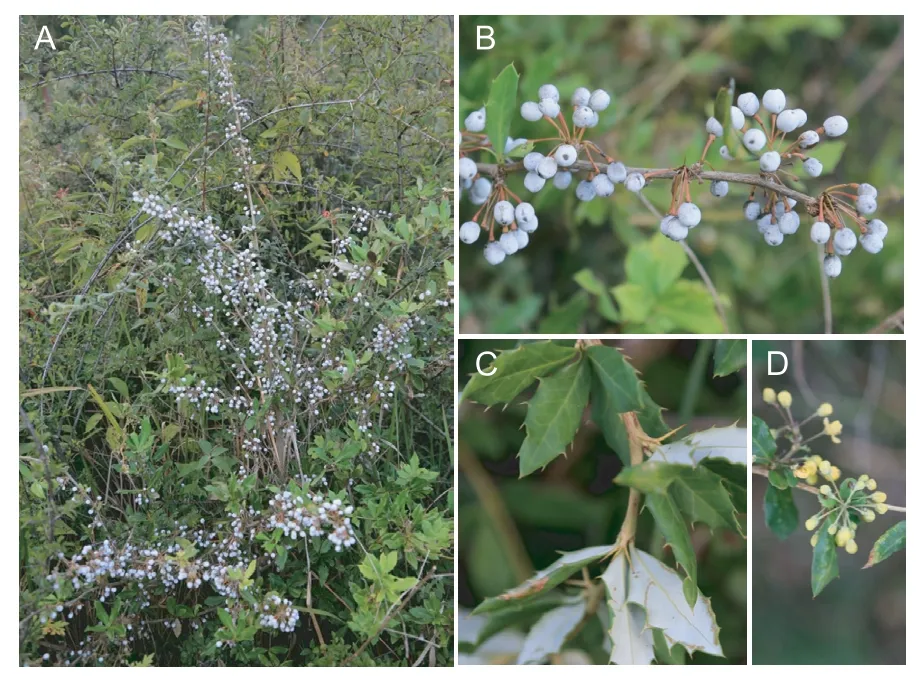
Fig.3 A typical example of a Berberis species (B.pruinosa)naturally growing and widely distributed in Yunnan Province,China. A,barberry bushes. B,berries covered with waxy bloom. C,the adaxial surface and abaxial side of leaves. D,inflorescence.
Wheat stripe rust is a major disease in the Yunnan-Guizhou plateau. The disease has occurred seriously in the past several decades (since the 1940s) in this area,especially in Yunnan wherePstis apt to generate genetic variation and produce a variety of virulent races (Li 2013).However,whether epidemics of wheat stripe rust are related to the presence of susceptible barberry plants is unknown. The present study and a previous study (Zhaoet al.2013) identified 17Berberisspecies susceptible toPstin this region. Natural rust infections on plants of two barberry species,B.pruinosain Yunnan andB.wilsonaevar.guhtzunicain Guizhou,were observed in early spring 2016 based on our field surveys. However,we failed to obtainPstisolates from aeciospores produced on naturally infectedBerberisplant tissues. So far,no evidence has shown that the presence of widespread susceptible barberry plants is associated with epidemics of wheat stripe rust or the high genetic diversity in the Yunnan-Guizhou plateau.
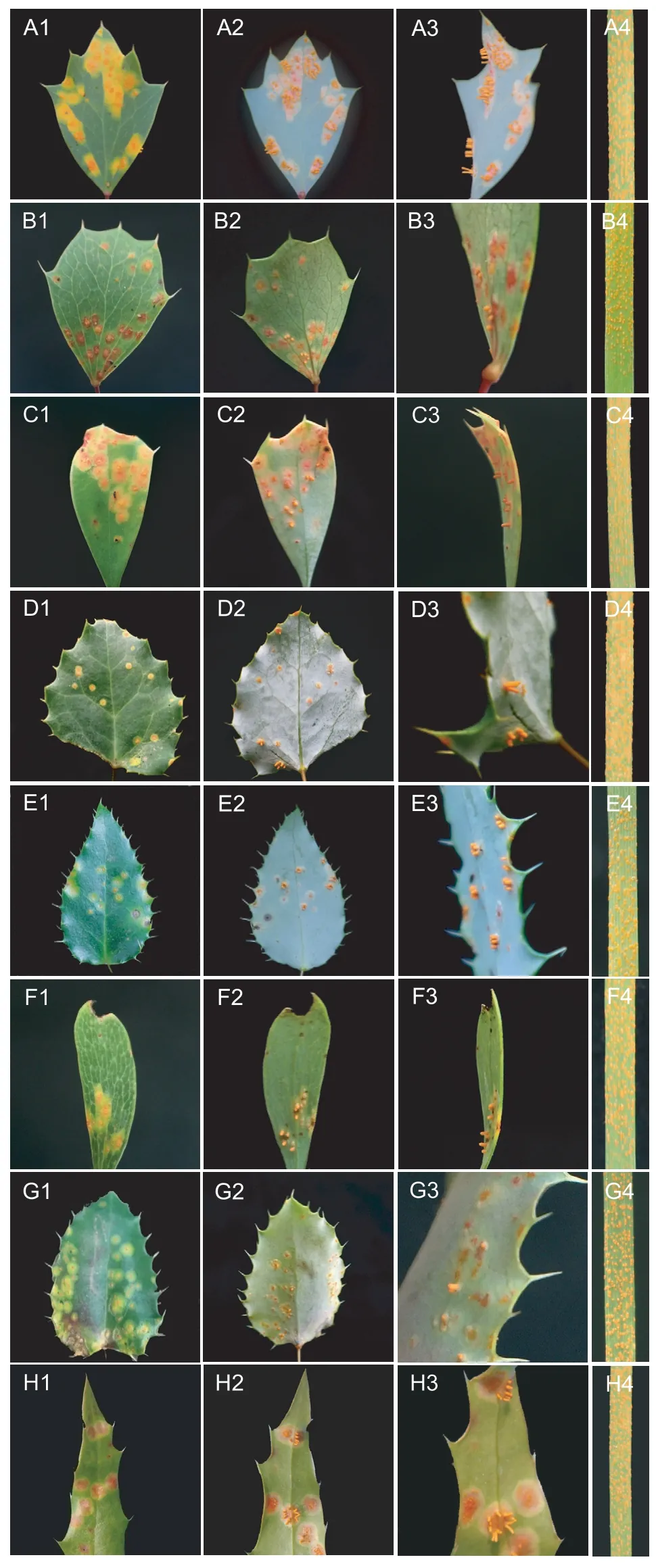
Fig.4 Evidence of Pst susceptibility for the eight Berberis species collected from Yunnan and Guizhou provinces,China.A,B.wilsonae. B,B.wilsonae var.guhtzunica. C,B.lepidifolia.D,B.pruinosa. E,B.veitchii. F,B.franchetiana. G,B.tsienii.H,B.julianae. 1,pycnial stage;2,aecial stage;3,side of aecial cups;4,uredinia on wheat cv.Mingxian 169.
Appropriate temperatures and continual high relative humidity are very important for teliospore germination ofPst.It had been reported that teliospore germination ofPstcan commence at a wide temperature range of 5–22°C under laboratory conditions (Wang and Chen 2015). The Yunnan-Guizhou plateau is located in the southwestern part of China and it is also mountainous,in which weather conditions are mild with cool temperatures in summer and warm in winter.The average temperature ranges from 19–22°C in Yunnan and 22–25°C in Guizhou in July,which is the hottest month,and 6–8°C in Yunnan and 3–6°C in Guizhou in January,which is the coldest month. Thus,temperatures in most months in the Yunnan-Guizhou plateau are suitable for teliospore germination. Based on our tests in the laboratory,Pstteliospores can germinate below 5°C and above 22°C but at a low germination rate (data not shown). The Yunnan-Guizhou plateau belongs to subtropical humid zone and has plenty of rainfall year-round,especially April to November,providing a long period of humid climatic conditions.
The overlap of vital teliospores and regrowth of young tissues of barberry bushes (mainly young leaves) are necessary for the occurrence ofPstsexual reproduction under natural conditions. According to a previous study by Zhaoet al.(2013) and the present study,manyBerberisspecies distributed in the Yunnan-Guizhou plateau were known to serve as alternate hosts forPstand are deciduous or evergreen,which are widespread in the Yunnan-Guizhou plateau. Based on our field investigations in this region in recent years,regrowth of young shoots on either deciduous or evergreenBerberisspecies in early spring and evergreenBerberisspecies in autumn is quite common in this region.Moreover,teliospore formation in wheat fields in the Yunnan-Guizhou plateau can be observed routinely in early February and teliospores possessed germinability (data not shown).Thus,overlapping of vital teliospores and regrowth of young leaves of barberry is present,which provides the potential for the possible occurrence of sexual reproduction ofPst.
The widespread distribution of susceptibleBerberisspecies and routine occurrence ofPstsexual reproduction under natural conditions has been demonstrated to contribute to the generation of new races and high genetic diversity ofPstpopulations in some regions of China,including southern Gansu as a hot-spot forPst(Duanet al.2010;Mboupet al.2010;Zhaoet al.2013;Liet al.2016;Wanget al.2016),andP.graminis(Berlinet al.2012).Previous studies revealed that thePstpopulations from Yunnan and Guizhou present high genetic diversity (Li 2013;Liuet al.2016;Jianget al.2018),similar to those from southern Gansu. The YunnanPstpopulation also exhibited diverse haploid genotypes,possessing shared haploid genotypes with the southern GansuPstpopulation(Li 2013). Presumably,Pstsexual reproduction could occur on susceptibleBerberisspecies under natural conditions and contribute to high genetic diversity.
5.Conclusion
This study carried out field surveys of geographic distribution ofBerberisspecies at 49 sites in the Yunnan-Guizhou plateau,43 of which were found to have barberry plants.EightBerberisspecies,B.julianae,B.tsienii,B.veitchii,B.wilsonae,B.wilsonaevar.guhtzunica,B.franchetiana,B.lepidifoliaandB.pruinosa,were reported here for the first time to serve as alternate hosts forPuccinia striiformisf.sp.tritici. These findings provide useful information for further studies to determine the role ofBerberisspecies in stripe rust epidemics under natural conditions.
Acknowledgements
We are thankful to Prof.Andrew O.Jackson at University of California,Berkeley,CA,USA and Prof.Xianming Chen at Wheat Health,Genetics and Quality Research Unit,United States Department of Agriculture-Agricultural Research Service,Pullman,WA,the United States and Department of Plant Pathology,Washington State University,Pullman,WA,the United States for reviewing the manuscript. This work was supported by the National Key R&D Program of China (2018YFD0200500),the National Natural Science Foundation of China (31960524,31071641 and 32072358),the Fundamental Research Funds for the Central Universities (2452019046),and the Natural Science Basic Research Plan in Shaanxi Province of China (2020JZ-15,2017JM3006).
Declaration of competing interest
The authors declare that they have no conflict of interest.
Appendixassociated with this paper is available on http://www.ChinaAgriSci.com/V2/En/appendix.htm
杂志排行
Journal of Integrative Agriculture的其它文章
- Low glycemic index:The next target for rice production in China?
- Effect of side deep placement of nitrogen on yield and nitrogen use efficiency of single season late japonica rice
- Advancements in plant regeneration and genetic transformation of grapevine (Vitis spp.)
- Indica rice restorer lines with large sink potential exhibit improved nutrient transportation to the panicle,which enhances both yield and nitrogen-use efficiency
- Effects of nitrogen management on the ratoon crop yield and head rice yield in South USA
- Response of grain-filling rate and grain quality of mid-season indica rice to nitrogen application
